Turkmenistan’s Struggles with Emissions
This coming November, the annual United Nations Climate Change Conference (COP 28) will be taking place. This conference will be focused on carbon capture, utilization, and storage. Turkmenistan has recently been facing pressure from the international community in regard to its significant contribution to methane emissions and it would not be a surprise if these emissions are brought up as a topic during the conference.
But why is such a high volume of Methane gas emissions a concern? Methane is a greenhouse gas that is far more potent compared to other gases, such as carbon dioxide (CO2). For example, in 2021 Turkmenistan emitted over 5 million tons of methane which is equivalent to 366 million tons of CO2. A study done by the Guardian revealed that methane leaks from Turkmenistan’s two main fields contributed more in 2022 to carbon emissions than the entirety of the United Kingdom [1].
President Serdar Berdimuhamedov of Turkmenistan recently approved a roadmap for 2023-2024 in order to help curb these emissions. The measures in the roadmap, “Include improving national legislation, cooperation with foreign partners to set up pilot projects and collaboration with IMEO (International Methane Emissions Observatory of the UN)” [2].
Even with these initiatives taking place in hopes to lower emissions at their current production rate, what happens if production were to increase?
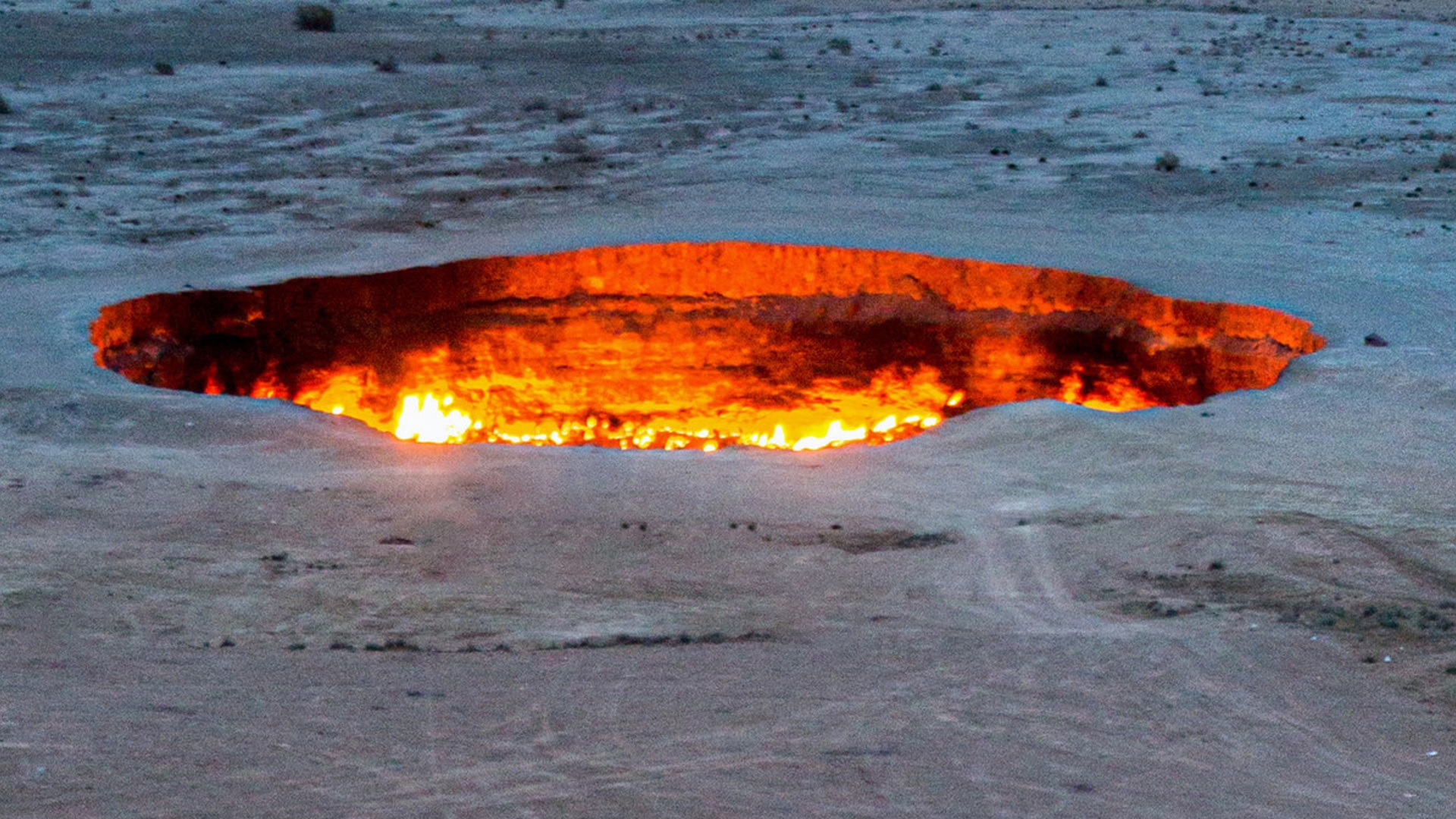
Undeveloped Resources
Turkmenistan’s natural gas reserves remain largely untouched due to its geographic location limiting access to markets. The country is in possession of the 4th largest natural gas reserves in the world but is producing only 79.3 bcm, 36.7 bcm of which is consumed domestically, and 30 bcm is being exported to China, the remaining is exported to Iran.
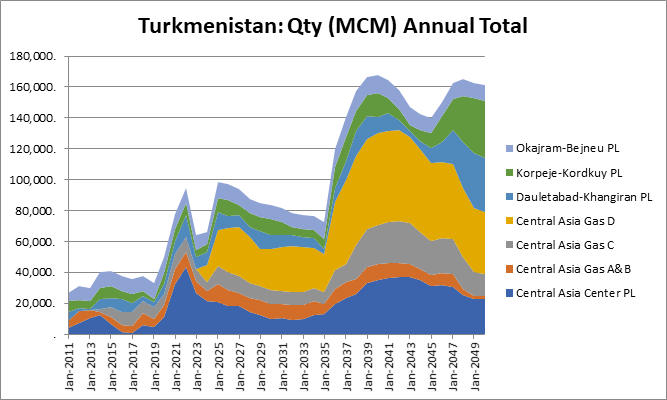
In 2012, Turkmenistan announced that its natural gas
production target for 2030 was going to be 250 bcm [3]. In addition to this
production target, the country was also planning to be exporting 180 bcm by
2030 to go along with the increased production which could turn into a massive
source of income. In addition to major expansions of the Central Asia Gas
Pipeline to China, to reach these goals, Turkmenistan is counting on unexplored
fields and the construction of two new U.S. backed pipelines. “One of the
planned pipelines is set to run across the Caspian Sea to Azerbaijan and
further to the European Union, where it could ease the bloc’s dependence on
Russian gas. The other pipeline, named TAPI after the countries ready to take
part in it, is expected to run from Turkmenistan to Afghanistan and then to
Pakistan and India.”

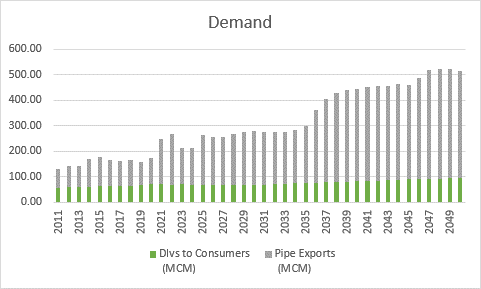
Turkmenistan’s Forecasted Supply and Demand. Source: G2M2® Market Simulator for Global Gas and LNG™
Trans-Caspian Pipeline
The proposal for a subsea pipeline that would run between Turkmenistan and Azerbaijan via the Caspian Sea was first suggested by the United States in 1996. This project was of great interest because not only would it allow for natural gas from Turkmenistan to be supplied to Europe, but it would also do so by bypassing both Russia and Iran. This, of course drew the ire of these two countries and was quickly shutdown due to a combination of their opposition, legal disputes regarding the territorial boundaries within the Caspian Sea [4], and the discovery of natural gas on Azerbaijan’s Shah Deniz field [5]. Alexander Golovin, who at the time was Moscow’s special envoy on Caspian Sea issues, stated, “A major gas pipeline would pose a serious, dangerous risk to the prosperity of the entire region” [6].
In one of our previous articles from 2019 [7], we utilized G2M2® Market Simulator for Global Gas and LNG™ to see the effects of a scenario in which there was a shutdown of gas in transit across Ukraine from Russia. Two conclusions were made from this scenario analysis that would both be achieved if this pipeline were to come online. The conclusion was that in the event of this proposed shutdown, gas would be needed from both Azerbaijan and Turkmenistan to support Europe. “Completion of new pipelines such as Turkish Stream, Trans-Caspian Pipeline, and Nord Stream 2 would help, but not be sufficient.”
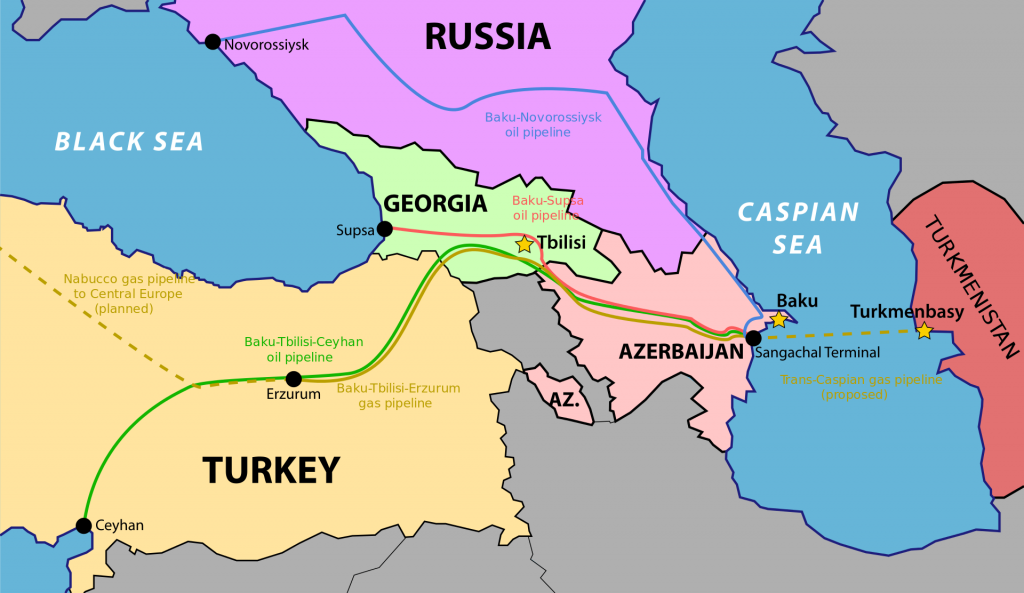
In 2006, interest in this project was renewed due to a dispute between Russia and Ukraine regarding gas supply, prices, and debts [8]. After years of back and forth negotiating, in 2021 the project finally seemed to be making headway towards beginning construction.
Turkmenistan’s government reported that, “External conditions for construction of Trans-Caspian gas pipeline of the total length of 300 km between Turkmen and Azeri coasts of Caspian Sea have become more favorable in the last years. Signing of the Convention on Legal Status of the Caspian Sea by five Caspian states on August 12, 2018 was very important. Another obstacle was covered on January 21 this year when the Memorandum of Understanding on joint exploration and development of hydrocarbon resources of Dostluk offshore field has been signed between the governments of Turkmenistan and Azerbaijan. The document has been already ratified by the Parliament of Turkmenistan” [9]. If completed, this pipeline is expected to, “Supply 30 billion cubic meters of natural gas to Europe by Trans-Caspian pipeline for 30 years.
Turkmenistan–Afghanistan–Pakistan–India Pipeline
Another pipeline that was proposed in addition to the Trans-Caspian was the Turkmenistan–Afghanistan–Pakistan–India Pipeline (TAPI). This pipeline started construction in 2015, but as of 2023 construction efforts have come to a standstill.

Recently however, “Pakistan has shown a willingness to go on with the Turkmenistan-Afghanistan-Pakistan-India (TAPI) gas pipeline project even without India as Afghanistan is willing to offer more support, the Minister of State for Petroleum and Natural Resources, Musadik Malik, said during his recent visit to Saudi Arabia” [10]. He also noted that if India were to withdraw from the project that, Pakistan could be willing to purchase India’s share of gas. It was also noted that even if Turkmenistan and Pakistan are eager to restart the project, challenges within Afghanistan remain a significant hurdle to overcome.
Potential transit revenue from this pipeline would make up, “Around 80 to 85% of Afghanistan’s annual budget.” Afghani leadership has expressed that they would be interested in forming a security force for the sole purpose of ensuring the safety of the pipeline. Saudi Arabia is hesitant that these challenges will be overcome so easily, but if all of their concerns are addressed then they would be interested in joining the project.
If Saudi Arabia were to join this project, “It could open up new possibilities and make Pakistan, Turkmenistan, and Saudi Arabia joint exporters of LNG, which would be welcomed by energy-starved Europe and the West.” If completed, this pipeline is expected to supply up to 33 bcm to the aforementioned countries [11].
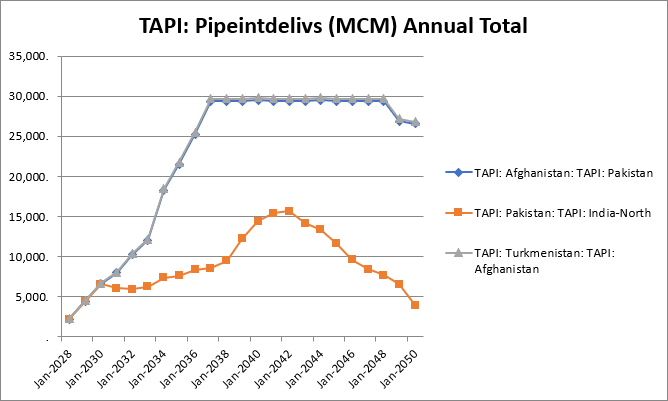
In addition, there was a separate project proposed in
which, “Natural gas from Turkmenistan can be brought to Gwadar via a gas
pipeline from Chaman, converted into LNG, and exported,” but this is merely a
proposal and is assumed to be in still very early planning stages. Even
with Turkmenistan taking steps to curb their emissions and progress being made
towards new projects which should bring new life into their natural gas industry,
only time will tell if these efforts prove fruitful.
G2M2 is
a valuable tool for staying up to date with not only developments regarding
these projects but for keeping track of the global market as a whole. In this
case, it has been used to project the effects that the Trans-Caspian and TAPI
pipelines could have on existing pipelines and on markets throughout the
world.
To find out more, please contact RBAC Inc here.
[1] Carrington, D. (2023, May 9). ‘Mind-boggling’ methane emissions from Turkmenistan revealed. The Guardian. https://www.theguardian.com/world/2023/may/09/mind-boggling-methane-emissions-from-turkmenistan-revealed
[2] Carrington, D. (2023b, June 13). Turkmenistan moves towards plugging massive methane leaks. The Guardian. https://www.theguardian.com/environment/2023/jun/13/turkmenistan-moves-towards-plugging-massive-methane-leaks
[3] Gurt, M. (2012, September 13). Reclusive Turkmenistan ups 2030 natural gas target. U.S. https://www.reuters.com/article/turkmenistan-gas-idINL5E8KD88M20120913
[4] BBC News. (2018, August 12). Caspian Sea: Five countries sign deal to end dispute. BBC News. https://www.bbc.com/news/world-45162282
[5] Shah Deniz | Who we are | Home. (n.d.). Azerbaijan. https://www.bp.com/en_az/azerbaijan/home/who-we-are/operationsprojects/shahdeniz.html
[6] Blagov, S. (2017). Russia Tries To Scuttle Proposed Trans-Caspian Pipeline. Eurasianet. https://eurasianet.org/russia-tries-to-scuttle-proposed-trans-caspian-pipeline
[7] Brooks, R. (2022). Putin Knew. RBAC Inc. https://rbac.com/putin-knew/
[8] INTEREST REBOUNDS IN TRANS-CASPIAN PIPELINE FOR TURKMEN GAS – Jamestown. (2016, September 20). Jamestown. https://jamestown.org/program/interest-rebounds-in-trans-caspian-pipeline-for-turkmen-gas/
[9] Development of gas transport system of Turkmenistan for the years of independence. (2023, July 5). https://turkmenistan.gov.tm/en/post/55379/development-gas-transport-system-turkmenistan-years-independence
[10] Onyango, D. (2023b, February 10). Pakistan to Move Forward with TAPI Gas Pipeline Project Even Without India. Pipeline Technology Journal. https://www.pipeline-journal.net/news/pakistan-move-forward-tapi-gas-pipeline-project-even-without-india
[11] Adbheadhoncho. (2023, January 24). Turkmenistan-Afghanistan-Pakistan-India Natural Gas Pipeline Project, Phase 3. Asian Development Bank. https://www.adb.org/projects/44463-013/main


